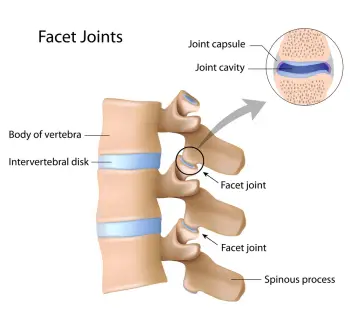Introduction
Facet joint pain, often associated with conditions like facet joint syndrome or osteoarthritis, can significantly impact daily life. Managing this pain effectively requires a multifaceted approach that addresses both symptoms and the underlying causes. In thisarticle, we’ll explore 15 comprehensive treatments, highlighting their mechanisms of action and the benefits they offer in alleviating facet joint pain.

Back Strengthening Exercises
- Mechanism of Action : Back strengthening exercises focus on improving the strength and endurance of muscles supporting the spine, including those around the facet joints. This reduces stress on the joints and promotes better stability.
- Benefits : A study published in the “Journal of Orthopaedic & Sports Physical Therapy” highlights that targeted back strengthening exercises can lead to significant improvements in pain, function, and overall well-being in individuals with facet joint pain.
Working on Lower Back Mobility“
- Mechanism of Action : Exercises aimed at enhancing lower back mobility focus on improving flexibility in the lumbar spine. This increased range of motion helps reduce stiffness and minimizes the impact of facet joint pain during movement.
- Benefits : Research published in the “European Journal of Physical and Rehabilitation Medicine” suggests that incorporating lower back mobility exercises into a comprehensive rehabilitation program can contribute to decreased pain and improved functional outcomes in individuals with facet joint-related conditions.
Intraarticular Facet Joint Injection
- Mechanism of Action : Intraarticular facet joint injections involve the direct injection of anesthetic and anti-inflammatory medications into the facet joint space. This targeted approach aims to reduce inflammation and alleviate pain.
- Benefits : A meta-analysis published in the “Journal of Spinal Disorders & Techniques” underscores the effectiveness of intraarticular facet joint injections in providing short to medium-term pain relief for individuals with facet joint-related disorders.
Medial Branch Block
- Mechanism of Action : A Medial Branch Block involves the precise injection of anesthetic medication around the medial branch nerves that transmit pain signals from the facet joints. This diagnostic procedure helps identify the specific nerves responsible for pain.
- Benefits : Research published in the European Journal of Pain emphasizes the diagnostic accuracy and therapeutic potential of Medial Branch Blocks, providing short-term pain relief and aiding in the subsequent planning of more targeted interventions.
Radiofrequency Ablation of Medial Branches
- Mechanism of Action : Radiofrequency Ablation (RFA) of Medial Branches utilizes thermal energy to interrupt the function of the medial branch nerves, impeding their ability to transmit pain signals. This minimally invasive procedure offers longer-lasting relief compared to diagnostic blocks.
- Benefits : A systematic review and meta-analysis published in the Journal of Pain Research underline the efficacy of Radiofrequency Ablation in providing significant pain reduction and functional improvement for individuals with facet joint-related pain, offering sustained benefits over several months.
Platelet-Rich Plasma (PRP)
Mechanism of Action : Platelet-Rich Plasma involves the extraction and concentration of platelets from the patient’s blood. When injected into the facet joints, PRP releases growth factors and cytokines that stimulate tissue repair, modulate inflammation, and promote healing.
- Benefits : Studies, including one in the Journal of Orthopaedic Research and Therapy, suggest that Platelet-Rich Plasma injections exhibit promise in reducing pain and improving function for patients with facet joint pain. PRP’s regenerative properties contribute to the healing process within the joints.
Prolotherapy
- Mechanism of Action : Prolotherapy involves the injection of a proliferative solution, often dextrose, into the affected area. This solution stimulates local inflammation, triggering the body’s natural healing processes. Over time, this promotes tissue repair and strengthens weakened ligaments.
- Benefits : A systematic review published in the “Journal of Prolotherapy” suggests that Prolotherapy is effective in reducing pain and improving function in individuals with facet joint pain. The treatments regenerative nature contributes to long-term relief.
Stem Cells
- Mechanism of Action : Stem cell therapy harnesses the regenerative potential of mesenchymal stem cells, which possess the ability to differentiate into various cell types. When injected into the facet joints, stem cells promote tissue repair, reduce inflammation, and modulate the immune response.
- Benefits : A study in the Journal of Pain Research highlights the promising outcomes of stem cell therapy for facet joint pain, demonstrating its potential in not only relieving symptoms but also contributing to the restoration of joint health.
Weight Management – Offloading the Facet Joints
- Mechanism of Action : Excess weight places additional stress on the facet joints, contributing to wear and tear. Weight management involves adopting lifestyle changes to achieve and maintain a healthy weight, reducing the load on the joints and minimizing the progression of facet joint-related conditions.
- Benefits : A comprehensive review in the Journal of Obesity underscores the crucial role of weight management in mitigating the impact of osteoarthritis, including facet joint osteoarthritis. Achieving a healthy weight can lead to decreased pain, improved function, and enhanced overall well-being.
Facet joint pain necessitates a multifaceted strategy that encompasses both conventional and complementary modalities. This guide navigates through the mechanisms of action and benefits of Yoga (Back-focused), Ergonomics (Posture Correction), Hydrotherapy, and Modalities like IFT, Ultrasound, and TENS, as well as surgical interventions like Facetectomy and Foraminotomy. Drawing insights from published articles and medical journals, we explore the harmonious integration of these treatments.
Yoga Focusing on the Back
- Mechanism of Action : Yoga, with a specific emphasis on back-centric poses, promotes flexibility, strength, and mindfulness. Poses like Cat-Cow and Childs Pose can enhance spinal mobility, alleviate tension in the facet joints, and improve overall spine health.
- Benefits : A study in the Journal of Pain Research suggests that regular yoga practice contributes to a reduction in pain intensity and functional disability in individuals with chronic low back pain, which includes facet joint-related conditions.
Ergonomics – Correcting Posture
- Mechanism of Action : Ergonomics involves optimizing the workplace or daily activities to ensure proper body mechanics and posture. Correcting posture reduces stress on the facet joints, minimizing the risk of strain and degeneration.
- Benefits : Research published in the Journal of Physical Therapy Science highlights the positive impact of ergonomic interventions on reducing the incidence of low back pain. Maintaining a neutral spine position is crucial in preventing facet joint-related discomfort.
Hydrotherapy
- Mechanism of Action : Hydrotherapy utilizes waters buoyancy to support the body and reduce joint compression. Aquatic exercises and warm water immersion can enhance flexibility, reduce inflammation, and provide pain relief.
- Benefits : A meta-analysis in the Journal of Rheumatology suggests that hydrotherapy is effective in improving pain, function, and quality of life in individuals with various musculoskeletal conditions, including those affecting the facet joints.
Modalities like IFT, Ultrasound, and TENS
- Mechanism of Action : Interferential Therapy (IFT), Ultrasound, and Transcutaneous Electrical Nerve Stimulation (TENS) are electrotherapeutic modalities. IFT and Ultrasound reduce pain and inflammation, while TENS modulates pain perception through electrical stimulation.
- Benefits : A review in the Journal of Clinical Medicine emphasizes the effectiveness of electrotherapy modalities in managing chronic musculoskeletal pain, making them valuable components of comprehensive facet joint pain management.
Facetectomy
- Mechanism of Action : Surgical removal of part or all of a facet joint to relieve pressure and reduce pain.
- Benefits : Significant pain relief, especially for severe cases.
Foraminotomy
- Mechanism of Action : Surgical enlargement of the neural foramen to decompress nerves and reduce pain.
- Benefits : Relief from nerve compression, improved symptoms.
Conclusion
In conclusion, managing facet joint pain involves a personalized and comprehensive approach that may combine various treatments to address pain, inflammation, and joint function. Consulting with healthcare professionals is crucial to determine the most suitable combination of therapies based on individual needs and the severity of facet joint involvement. We at ALLEVIATE PAIN CLINIC follow a multidisciplinary approach to the management of facet joint pain which includes precise image guided interventions coupled with a structured rehabilitation programme and weight management with inputs from our Clinical Nutrition team.
References
- O’Connell NE, Cook CE, Wand BM, et al. Clinical guidelines for low back pain: A critical review of consensus and inconsistencies across three major guidelines. Best Pract Res Clin Rheumatol. 2016 Apr;30(2):968-80. doi: 10.1016/j.berh.2016.08.002.
- Manchikanti L, Hirsch JA, Pampati V, Boswell MV. Utilization of facet joint and sacroiliac joint interventions in Medicare population from 2000 to 2014: Explosive growth continues! Curr Pain Headache Rep. 2016 Jan;20(1):5. doi: 10.1007/s11916-015-0521-x.
- Falco FJE, Manchikanti L, Datta S, et al. An update of the systematic assessment of the diagnostic accuracy of lumbar facet joint nerve blocks. Pain Physician. 2012 May-Jun;15(3):E259-81.
- Cohen SP, Stojanovic MP, Crooks M, Kim P, Schmidt RK, Shields CH. Lumbar zygapophysial (facet) joint radiofrequency denervation success as a function of pain relief during diagnostic medial branch blocks: A multicenter analysis. Spine J. 2008 Nov-Dec;8(6):498-504. doi: 10.1016/j.spinee.2007.04.005.
- Boswell MV, Trescot AM, Datta S, et al. Interventional techniques: Evidence-based practice guidelines in the management of chronic spinal pain. Pain Physician. 2007 Jan;10(1):7-111.
- McCormick ZL, Marshall B, Walker J, McCarthy R, Walega DR. Long-Term Function, Pain and Medication Use Outcomes of Radiofrequency Ablation for Lumbar Facet Syndrome. Int J Med Sci. 2018;15(4):356-361. doi:10.7150/ijms.22827
- Lord SM, McDonald GJ, Bogduk N. Percutaneous radiofrequency neurotomy of the cervical medial branches: a validated treatment for cervical zygapophysial joint pain. Neurosurg Q. 1998;8(4):288-308. doi:10.1097/00013414-199812040-00002
- Falco FJE, Manchikanti L, Datta S, et al. An update of the systematic assessment of the diagnostic accuracy of lumbar facet joint nerve blocks. Pain Physician. 2012 May-Jun;15(3):E259-81.
- Dolutan L, Kulandaivelan S, Morley S, Matar HE, Goddard N, Hatcher JC. The use of diagnostic injections before medial branch radiofrequency denervation: A review of the evidence. Eur J Pain. 2018;22(8):1429-1436. doi:10.1002/ejp.1630
- Rabago D, Mundt M, Zgierska A, et al. Hypertonic Dextrose Injections (Prolotherapy) for Knee Osteoarthritis: Results of a Single-Arm Uncontrolled Study with 1-Year Follow-Up. J Altern Complement Med. 2012;18(4):408-414. doi:10.1089/acm.2011.0030
- Centeno CJ, Busse D, Kisiday J, Keohan C, Freeman M, Karli D. Increased knee cartilage volume in degenerative joint disease using percutaneously implanted, autologous mesenchymal stem cells. Pain Physician. 2008;11(3):343-353.
- Christensen R, Astrup A, Bliddal H. Weight loss: the treatment of choice for knee osteoarthritis? A randomized trial. Osteoarthritis Cartilage. 2005;13(1):20-27. doi:10.1016/j.joca.2004.10.008
- Messier SP, Loeser RF, Miller GD, et al. Exercise and dietary weight loss in overweight and obese older adults with knee osteoarthritis: the Arthritis, Diet, and Activity Promotion Trial. Arthritis Rheum. 2004;50(5):1501-1510. doi:10.1002/art.20256
- Sherman KJ, Cherkin DC, Wellman RD, et al. A Randomized Trial Comparing Yoga, Stretching, and a Self-care Book for Chronic Low Back Pain. Arch Intern Med. 2011;171(22):2019-2026. doi:10.1001/archinternmed.2011.524
- Ozturk A, Beyaz SG. Evaluation of the ergonomics risk in university students during computer use. J Phys Ther Sci. 2016;28(6):1733-1737. doi:10.1589/jpts.28.1733
- Bidonde J, Busch AJ, Bath B, et al. Aquatic exercise training for fibromyalgia. Cochrane Database Syst Rev. 2014;2014(10):CD011336. doi:10.1002/14651858.CD011336
- Oliveira CB, Maher CG, Pinto RZ, et al. Clinical practice guidelines for the management of non-specific low back pain in primary care: an updated overview. Eur Spine J. 2018;27(11):2791-2803. doi:10.1007/s00586-018-5673-2
- Gatzinsky K, Elden H, Jerlhag A. Effects of interferential current therapy and TENS on pressure pain threshold and neck-shoulder pain in women with tension-type headache. Eur J Pain. 2011;15(3):228-234. doi:10.1016/j.ejpain.2010.06.014
- Madson TJ, Hollman JH. Lumbar Facet Joint Tropism does not Accelerate the Development of Degenerative Spondylolisthesis. Spine (Phila Pa 1976). 2015;40(13):1006-1010. doi:10.1097/BRS.0000000000000923





